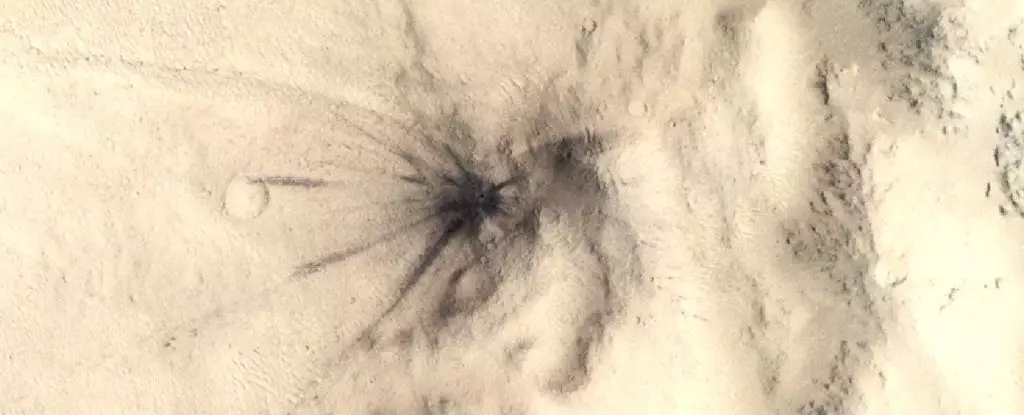Recent research has illuminated a fascinating aspect of Mars that challenges previously held notions regarding the planet’s geology and seismic activity. A comprehensive study employing artificial intelligence has unveiled the complex nature of marsquakes—not all of which are rooted in tectonic ceremonies beneath the planet’s crust. Instead, the findings suggest that many of these seismic events may originate from impacts on the Martian surface, prompting a reevaluation of our understanding of Mars’ dynamic processes and structure.
Understanding the seismic dynamics of Mars is critical for planetary scientists who study the formation and evolution of terrestrial bodies in our solar system. The research indicates an unexpected intensity of marsquakes along with an increase in the frequency of impacts—a stark contrast to earlier assumptions that deemed Mars relatively geologically inactive. The Martian landscape, historically viewed as a desolate terrain, is revealed to be more vibrant and eventful than anticipated. This discovery not only informs our understanding of Mars but also sheds light on the planetary formation processes shared among Earth, Mars, and Venus.
The Mars InSight lander, operational from 2018 to 2022, was pivotal in detecting over 1,300 marsquakes during its mission. Scientists initially believed that such quakes originated through geological processes similar to those on Earth. However, recent analysis led by planetary scientist Valentin Bickel from the University of Bern reveals that a significant number of these seismic events result from meteoroid impacts rather than tectonic shifts.
Using a machine learning algorithm, Bickel’s team scrutinized images captured by the HiRISE instrument on the Mars Reconnaissance Orbiter, identifying 123 new craters that appeared during the InSight mission. By correlating the dates and locations of these craters with seismic events detected by the lander, the researchers identified 49 instances where marsquakes aligned with impacts. This groundbreaking correlation also established that the rate of significant impacts on Mars could be up to 2.5 times higher than previously estimated.
Reassessing Martian Crust and Interior Dynamics
The deeper implications of this research extend well beyond mere statistics. The nature of seismic waves generated by both tectonic and impact-related activities was found to traverse further into Mars’ interior than previously believed. The notion previously held by scientists—that seismic waves were confined to the planet’s crust—has been challenged. Instead, these waves act as a ‘seismic highway,’ reaching depths into the mantle, permitting a more sophisticated mapping of Martian geology.
Particularly notable is the examination of the 21.5-meter (70.5-foot) crater located near Cerberus Fossae, a site known for its geological activity. This crater was directly linked to specific high-frequency marsquakes, suggesting that a significant portion of the seismic activity originally attributed to the region might actually stem from impacts. Constantinos Charalambous, a planetary scientist at Imperial College London, emphasizes this shift in interpretation, urging the scientific community to reconsider its understanding of seismic occurrences in this area of Mars.
The Broader Implications of Marsquake Research
The revelations from this research have far-reaching consequences for how we conceptualize Mars. They encourage a broader reevaluation of the planet’s internal processes, as well as assumptions made about its surface dynamics. A planet once thought to be nearly geologically inactive is now viewed as an environment full of impactful events, challenging preconceived notions about its history and development.
Moreover, these findings can enrich our understanding of planetary systems beyond our own. The shared attributes of Mars, Earth, and Venus suggest that investigations into the seismic activities across different celestial bodies can yield valuable insights into their formative processes and evolutionary trajectories. The interplay between impact events and geological activity serves as a reminder that planets are dynamic systems, continually shaped by both external and internal forces.
Ultimately, the study of marsquakes illustrates the continuously evolving landscape of planetary science. As the methods for analyzing planetary interiors advance—especially with the use of artificial intelligence—we can anticipate more revelations that will refine our comprehension of Mars and other celestial neighbors. The intricate dance between seismic activity and impacts outlines a narrative of ongoing transformation: one that may redefine our understanding not only of Mars but also of the broader cosmos in which it resides. The ongoing exploration and analysis of Mars promise to uncover even more complexities, and future missions may delve deeper into these enigmatic geological processes, further bridging the gaps in our knowledge of this intriguing planet.

